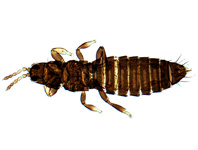Abstract
The number of alien species in the Mediterranean Sea is steadily increasing and it seems that the pace has been accelerating since the turn of the century (Galil et al. 2014). In 2015 alone five additional fish species have been reported, Epinephelus geoffroyi (Klunzinger, 1870) (Golani et al. 2015); Stolephorus indicus (van Hasselt, 1823) (Fricke et al. 2015); Sardinella gibbosa (Bleeker, 1849) (Stern et al. 2015); Mobula japanica (Müller & Henle, 1841) (Capapé et al. 2015); and Cryptocentrus caeruleopunctatus (Rüppell, 1830) (Rothman & Goren 2015). Among the ca. 100 alien fish species reported from the Mediterranean to date (Galil & Goren 2014), five Indo-Pacific species belong to the genus Epinephelus Bloch, 1793: Epinephelus coioides (Hamilton, 1822), Epinephelus fasciatus (Forsskål, 1775), Epinephelus malabaricus (Bloch and Schneider, 1804) Epinephelus merra Bloch, 1793 (Golani et al. 2013a) and Epinephelus geoffroyi (Klunzinger, 1870) (Golani et al. 2015). Additional alien Epinephelus species reported from the Mediterranean are excluded for various reasons (Golani et al. 2013b). Here we report the finding of a sixth Indo-Pacific species of this genus along the Mediterranean coast of Israel.
References
Briggs, J. (1974) Marine ZoogeographyMcGraw-Hill. McGraw-Hill, New York, 475 pp.
Briggs, J.C. (1999) Extinction and replacement in the Indo West Pacific Ocean. Journal of Biogeography, 26, 777–783.
http://dx.doi.org/10.1046/j.1365-2699.1999.00322.xCapapé, C., Rafrafi-Nouira, S., El Kamel-Moutalibi, O., Boumaiza, M. & Reynaud, C. (2015) First Mediterranean records of spine tail devil ray, mobula japanica (Elasmobranchii: Rajiformes: Mobulidae). Acta Ichthyologica et Piscatoria, 45, 211–215.
http://dx.doi.org/10.3750/AIP2014.45.2.13Forsskål, P. (1775) Descriptiones animalium, avium, amphibiorum, piscium, insectorum, vermium, quae in itinere orientali observavit Petrus Forskal... edidit Carsten Niebuhr. Adjuncta est materia medica kahirina atque tabula Maris Rubri geographica. ex-officina Mölleri, Hauniae, 20 + xxxiv + 164 pp.
Fricke, R., Golani, D. & Appelbaum-Golani, B. (2015) First record of the Indian anchovy Stolephorus indicus (van Hasselt, 1823) (Clupeiformes: Engraulidae) in the Mediterranean Sea. BioInvasions Records, 4, 1–5.
http://dx.doi.org/10.3391/bir.2015.4.4.11Froese, R. & Pauly, D. (2015) World Wide Web electronic publication. Available from: http://www.fishbase.org (accessed 10 October 2015)
Gaither, M.R. & Rocha, L.A. (2013) Origins of species richness in the Indo-Malay-Philippine biodiversity hotspot: evidence for the centre of overlap hypothesis. Journal of Biogeography, 40, 1638–1648.
http://dx.doi.org/10.1111/jbi.12126Galil, B.S. & Goren, M. (2014) Metamorphoses: Bioinvasions in the Mediterranean Sea. In: Goffred, S. & Dubinsky, Z. (Eds.), The Mediterranean Sea: Its History and Present Challenges. Springer, Leiden, pp. 463–478.
Galil, B.S., Marchini, A., Occhipinti-Ambrogi, A., Minchin, D., Narščius, A., Ojaveer, H. & Olenin, S. (2014) International arrivals: widespread bioinvasions in European Seas. Ethology Ecology & Evolution, 26, 152–171.
http://dx.doi.org/10.1080/03949370.2014.897651Golani, D., Orsi-Relini, L., Massuti, E., Quignard, J.P., Dulčić, J. & Azzurro, E. (2013a) CIESM Atlas of Exotic Fishes in the Mediterranean. Check-list of exotic species. Available from: http://www.ciesm.org/atlas/appendix1.html (accessed 10 March 2015)
Golani, D., Orsi-Relini, L., Massuti, E., Quignard, J.P., Dulčić, J. & Azzurro, E. (2013b) CIESM Atlas of Exotic Fishes in the Mediterranean. List of excluded species. Available from: http://www.ciesm.org/atlas/appendix1bis.html (accessed 10 March 2015)
Golani, D., Askarov, G. & Dashevsky, Y. (2015) First record of the Red Sea spotted grouper, Epinephelus geoffroyi (Klunzinger, 1870) (Serranidae) in the Mediterranean. BioInvasions Records, 4, 143–145.
http://dx.doi.org/10.3391/bir.2015.4.2.12Heemstra, P.C. & Randall, J.E. (1993) FAO species catalogue vol. 16 groupers of the world (family Serranidae, subfamily Epinephelinae): An annotated and illustrated catalogue of the grouper, rockcod, hind, coral grouper, and lyretail species known to date. Food and Agriculture Organization of the United Nations, Rome, 382 pp.
Kimura, M. (1980) A simple method for estimating evolutionary rates of base substitutions through comparative studies of nucleotide sequences. Journal of Molecular Evolution, 16, 111–120.
http://dx.doi.org/10.1007/BF01731581Randall, J.E., Bogorodsky, S.V., Krupp, F., Rose, J.M. & Fricke, R. (2013) Epinephelus geoffroyi (Klunzinger, 1870)(Pisces: Serranidae), a valid species of grouper endemic to the Red Sea and Gulf of Aden. Zootaxa, 3641, 524–532.
http://dx.doi.org/10.11646/zootaxa.3641.5.2Rothman, S.B.S. & Goren, M. (2015) First record of the Red Sea shrimp-goby Cryptocentrus caeruleopunctatus in the Mediterranean Sea. Marine Biodiversity Records, 8, e157, 1–2.
http://dx.doi.org/10.1017/s1755267215001323Stamatakis, A. (2006) RAxML-VI-HPC: maximum likelihood-based phylogenetic analyses with thousands of taxa and mixed models. Bioinformatics, 22, 2688–2690. [Oxford, England]
http://dx.doi.org/10.1093/bioinformatics/btl446Stern, N., Rinkevich, B. & Goren, M. (2015) First record of the Goldstripe sardinella-Sardinella gibbosa (Bleeker, 1849) in the Mediterranean Sea and confirmation for its presence in the Red Sea. BioInvasions Records, 4, 47–51.
http://dx.doi.org/10.3391/bir.2015.4.1.08Tamura, K., Stecher, G., Peterson, D., Filipski, A. & Kumar, S. (2013) MEGA6: Molecular Evolutionary Genetics Analysis version 6.0. Molecular biology and evolution, 30, 2725–2729.
http://dx.doi.org/10.1093/molbev/mst197Ward, R.D., Zemlak, T.S., Innes, B.H., Last, P.R. & Hebert, P.D. (2005) DNA barcoding Australia's fish species. Philosophical transactions of the Royal Society of London.Series B, Biological sciences, 360, 1847–1857.
http://dx.doi.org/10.1098/rstb.2005.1716

